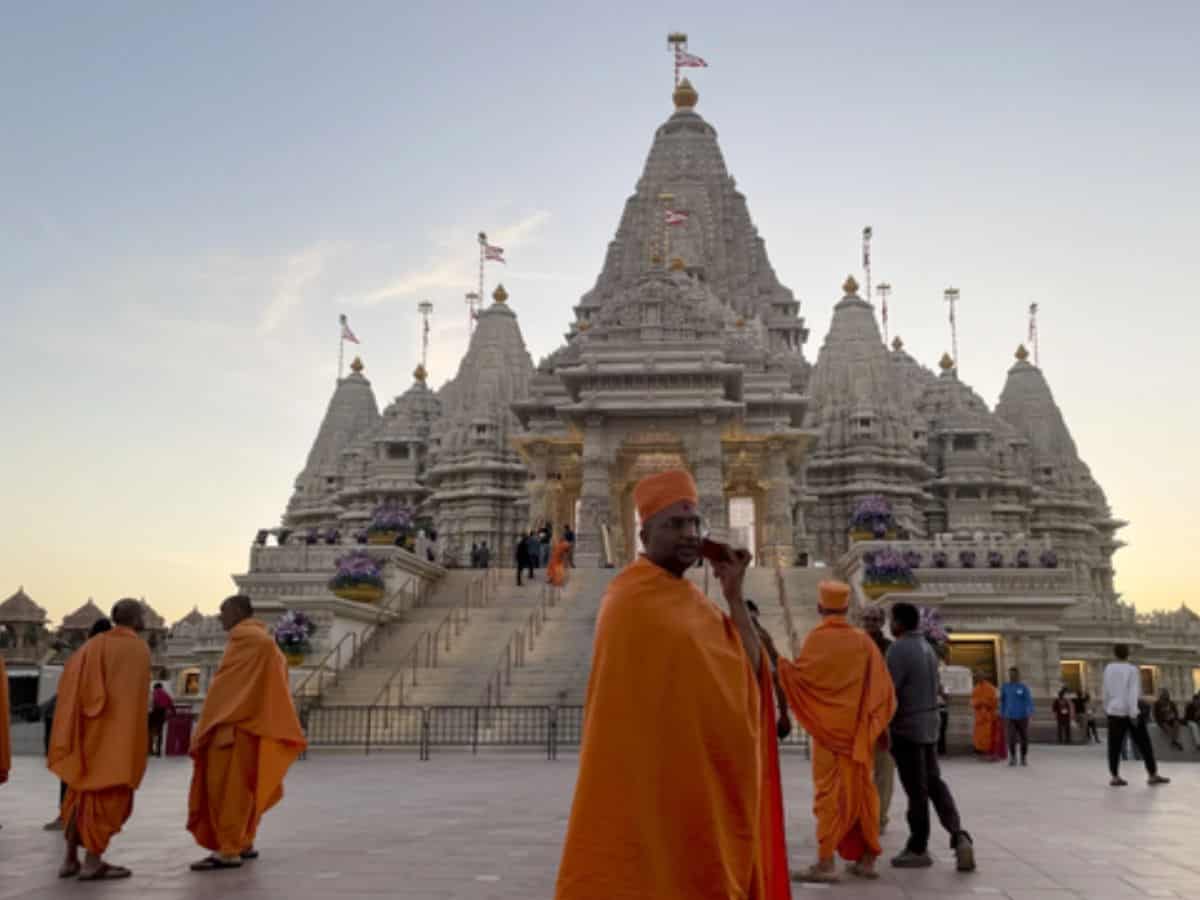
Robbinsville: The largest Hindu temple outside Asia — Swaminarayan Akshardham — will be thrown open for public in New Jersey on October 18.
It is claimed that the temple is larger than the Bridgewater Lord Venkateshwara temple in New Jersey and the Pittsburgh temple of the same name.
The Swaminarayan Akshardham temple was inaugurated on October 8. Sitting on a massive 185-acre plot in Robbinsville county of New Jersey, the temple was built by 12,500 volunteer workers from all over the world. The temple was in the works since 2011, but hit the headlines only a decade later for the wrong reasons, media reports said.
Swaminarayan Akshardham was built with 2 million cubic feet of stone, a spokesperson of the Bochasanwasi Shri Akshar Purushottam Swaminarayan Sanstha, known as BAPS, which has temples around the world, told NBC Asia news.
Placing 2 million cubic feet of stone in Robbinsville township was no small feat. And the temple itself is a cultural mix with materials sourced from all over the world. It also gives historical nods to American history on its walls, a spokesperson said.
For Indian Americans, it’s a massive milestone of an achievement, the spokesperson said.
Along the temple walls are carvings of historical figures like Martin Luther King Jr. and Abraham Lincoln.
“When you come to the mandir, you will see people of all genders, all castes and social backgrounds eating, praying, loving and serving together,” he said.
But the temple is not without controversies created by the labour force that built it. The impressive construction prompted a labor lawsuit, now on hold, with some saying it “raises questions about the thin line between religious service and labour exploitation”.
“I wake up every morning and scratch my eyes thinking, ‘Am I still in central New Jersey?’” said Yogi Trivedi, a temple volunteer and a scholar of religion at Columbia University.
“It’s like being transported to another world, specifically to India.”
“This is the American Dream,” he said, adding: “The sacred geography of India and beyond is here in this one place and you can experience, witness and admire it all here in New Jersey. I anticipate, as a scholar of religion, that this will become a popular place of pilgrimage for Hindus from across the world.”
To withstand cold New Jersey winters (anything between -5-degree C to -20-degree C), the outside of the temple has been built with non-traditional Bulgarian limestone. The inside features of the temple bear testimony to the stones imported from all over the world, ranging from Greece, Italy to India.
A traditional Indian stepwell contains waters from 300 sacred river bodies in India and all river waters from all 50 US states of the union.
Women were also actively engaged in key roles in running the project. Something rarely seen in temple construction.
“Now people who visit here from the American community will realise that the brown family two houses away from them is not all that different,” Trivedi said.
Trivedi said he sees the design as reminiscent of the community that will form in the temple — a mix of cultures with something for all people.
“That kind of inclusivity is not just talked about, it’s actually seen on the walls,” he said.
Built by 12,500 volunteers from all over the world, the Akshardham has been in the works since 2011. But it made headlines in the US media a decade later, sometime around 2021, when a group of immigrant labourers sued the global temple faith organisation. The lawsuit alleged “shocking” conditions, including forced labour, gruelling work hours, inhospitable living conditions and caste discrimination.
“For these long and difficult hours of work, the workers were paid an astonishing $450 per month, and even less when the defendants took illegal deductions,” the initial complaint said.
“Their hourly pay rate came to approximately $1.20 per hour.”
Many of the manual labourers involved in the temple’s construction came to New Jersey from India on religious visas and were Dalits, meaning they fell into historically marginalised groups in South Asia’s caste system. The lawsuit alleges that the temple leadership enforced that caste hierarchy at work, NBC reported .
The lawsuit has, however, been put on hold with 12 of the original 21 plaintiffs moving to dismiss their claims, and BAPS Akshardham spokespeople assure that the temple will be a place for people of all creeds and castes, claims Sakshi Venkatraman who filed the report for the NBC that has been circulated widely in the US media.
A spokesperson for BAPS was quoted by the NBC report as saying, “There’s a distinction between employment and religious volunteer service, known as seva.”
Some activists say the allegations still raise questions about the thin line between “religious service and work exploitation”, which Dalit communities are especially vulnerable to.
“The artisans who helped build our mandir came to the US as volunteers, not as employees,” spokesperson Ronak Patel said in a statement.
“We took care of the artisans’ needs in the US, including travel, lodging, food, medical care, and internet and prepaid phone cards so they could stay in touch with their families in India. BAPS India also supported the artisans’ families in India so they did not suffer financial hardship as a result of the artisans’ seva in the US.”
“A place of worship, a temple, is such an important space, especially for an immigrant community who’s making home in a new country,” said Viswanath, a co-founder of the civil rights group Hindus for Human Rights.
“I would want anybody who goes to the temple to really ask themselves, really do some soul searching, about going to a temple where there are such serious allegations of labour and human rights violations,” he added.
